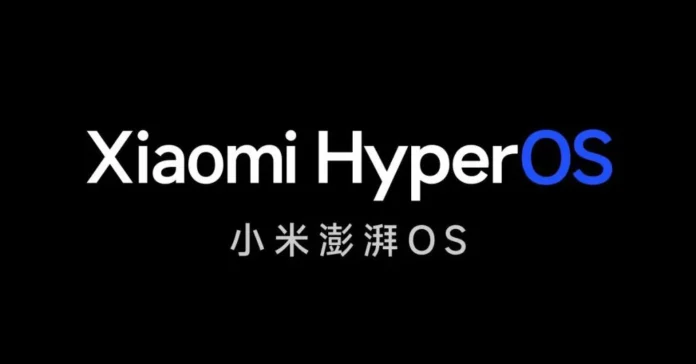Xiaomi has announced Xiaomi HyperOS, powering its smart ecosystem of personal devices, cars, and home products and will be pre-installed on the newly launched Xiaomi 14 Series, Xiaomi Watch S3, Xiaomi TV S Pro 85″ MiniLED, and other devices in its domestic markets.
Xiaomi HyperOS, in development since 2017 is designed to bring coherence to the IoT landscape and aims to unify all ecosystem devices into a single, integrated system framework. The ultimate goal is to deliver peak device performance, ensure consistent user experience, and facilitate seamless connectivity across all Xiaomi devices. Huawei has been working on its OS for sometime after the US blacklisted it on its Entity List which disallowed it from using Android OS and other US products.
The core of Xiaomi HyperOS is formed by Linux and Xiaomi’s self-developed Xiaomi Vela system. Xiaomi HyperOS’s underlying layer supports over 200 processor platforms and over 20 standard file systems, covering hundreds of device types and thousands of SKUs. Xiaomi HyperOS is naturally lightweight: the system firmware on smartphones occupies only 8.75GB, a significant improvement over competitors.
Xiaomi HyperOS supports task splitting across multiple computing units for cooperative processing, which maximizes hardware performance. Xiaomi HyperOS harmonizes all connected devices, allowing software to adapt to user needs. Seamlessly switch camera sources during video conferencing, access car cameras from your phone, access your smartphone’s rear camera while you’re using a tablet or a laptop, and even connect your tablet to the internet via your smartphone. Additionally, apps, clipboard content, and notifications can be moved effortlessly between devices as needed by the user.
HyperMind is the cognitive center of Xiaomi’s device ecosystem, bringing pioneering cross-device connections into the era of ‘proactive intelligence.’. HyperMind utilizes the four perceptual capabilities of devices – environment, vision, sound, and behavior, to learn user requirements and automatically adapt devices to their needs. For instance, if a user always turns on the living room light upon unlocking their smart door lock, HyperMind will automatically illuminate the room after learning this pattern, after requiring user consent. This innovation simplifies complex cross-device connectivity and reduces traditional machine learning costs, enabling users to enjoy the convenience of device connectivity without needing to understand intricate logic comprehension or trigger mechanisms.
Xiaomi HyperOS utilizes large foundation models, enabling them to empower system applications. Xiaomi AI Assistant now allows direct access to large foundation model text generation capabilities via its user interface, enabling tasks like speech generation and article summarization. The real-time subtitle feature has been enhanced to transcribe video conference conversations into notes and intelligent meeting summaries. Users can utilize spoken phrases to search for images in their photo albums and create AI images based on existing portraits. The tablet version of the “Mi Canvas” app adds an AI brush that can transform casual doodles into exquisite artwork. Furthermore, third-party applications can tap into the AI subsystem’s potential, such as document comprehension through screenshots within WPS, or single-command presentation generation.
To efficiently deploy large foundation models, Xiaomi HyperOS leverages its AI subsystem to integrate them into the device NPU. This support extends to Xiaomi’s self-developed large foundation models on smartphones, exemplified by the imaging foundation model, which has reduced model size and memory usage by 75% and decreased drawing time from 100 seconds to just 5 seconds.¹ These enhanced image generation capabilities are already enhancing features like Xiaomi AI Assistant’s ‘Text to Image’ and ‘Image Extender’ in device photo albums.
Xiaomi also announced the open-sourcing of Xiaomi Vela, an IoT software platform tailored for consumer IoT products. Based on the open-source NuttX real-time operating system, Xiaomi Vela provides a uniform software platform across various IoT hardware, simplifying development by abstracting underlying hardware differences and offering a unified software interface for upper-level developers. By making Xiaomi Vela open-source to IoT device manufacturers and developers, Xiaomi is fostering IoT device innovation, improving performance, and enabling real-time connectivity capabilities across a wide spectrum of devices.
Xiaomi HyperOS is a human-centric operating system designed and tailored to connect personal devices, cars, and smart home products in a smart ecosystem. The system marks a pivotal move forward in Xiaomi’s strategic vision of delivering the “Human x Car x Home” smart ecosystem. Xiaomi has achieved remarkable growth over the past 13 years, expanding from just 100 users to an impressive 1.175 billion users worldwide along with a product catalog now spanning over 200 categories.
The newly launched Xiaomi 14 Series will come pre-installed with Xiaomi HyperOS, together with devices launched in Xiaomi’s domestic markets, such as Xiaomi Watch S3, Xiaomi TV S Pro 85″ miniLED, and more.



